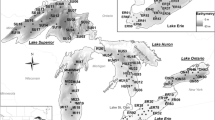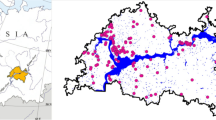Abstract
The aquatic vegetation present in lakes in the delta of the River Danube was studied using field survey data and satellite image. Based on the spectral information from satellite images, three categories of lakes were distinguished: clear / macrophyte-dominated, intermediate and turbid / poorly vegetated. The satellite-based classification was consistent with vegetation cover and water transparency measured in the field. Cluster analysis of vegetation data from 235 relevés made in 22 lakes (1996–1998, each year in June) identified ten submerged vegetation types. The lakes were characterised by the frequency of occurrence of each vegetation type and ordinated, using Principal Components Analysis (PCA). A strong relationship appeared between the composition and density of aquatic vegetation and water transparency. Isolated lakes within the extensive beds of floating reed (plaur lakes) formed a separate group. Based on the ordination analysis, connectivity of lakes in the Danube Delta was concluded to be a major factor for the development of dense macrophyte vegetation.
Access this chapter
Tax calculation will be finalised at checkout
Purchases are for personal use only
Preview
Unable to display preview. Download preview PDF.
Similar content being viewed by others
References
Chambers, P. A., 1987. Light and nutrients in the control of aquatic plant community structure: II In situ observations. J Ecol. 75: 621–628.
Heiler, G., T. Hein, F. Schiemer amp; G. Bornette, 1995. Hydrological connectivity and flood pulses as the control aspects for the integrity of a river–floodplain system. Regul Riv. 11: 351–361.
Heliotis, F., G. Vellidis, D. Bandacu amp; C. Pringle, 1994. The Danube Delta: historical wetland drainage and potential for restoration. In Mitsch, W. J. (ed.), Global Wetlands: Old World and New. Elsevier, Amsterdam: 759–767.
Hill, M. O., 1979. TWINSPAN, a FORTRAN program for arranging multivariate data in an ordered two-way table by classification of individuals and attributes. Cornell University, Thaca, N.Y.: 90 pp.
Janauer, G. A. amp; G. Kum, 1996. Macrophytes and floodplain water dynamics in the river Danube ecotone research region ( Austria ). Hydrobiologia 340: 137–140.
Lehmann, A. amp; J.-B. Lachavanne, 1997. Geographic information systems and remote sensing in aquatic botany. Aquat Bot 58: 195–207.
Smith, C. amp; N. Brown, 1997. ERDAS Field Guide. 4th edn. ERDAS Inc: 655 pp.
Spence, D. H. N., 1982. The zonation of freshwater plants. Adv ecol Res 12: 37–125.
Ter Braak, C. J. F., 1991. CANOCO, a FORTRAN program for canonical community ordination by (partial) (detrended) (canonical) correspondence analysis, principal components analysis and redundancy analysis. TNO Institute of Applied Computer Science, Wageningen: 95 pp.
Van den Berg, M. S., H. Coops, M. L. Meijer, M. Scheffer amp; J. Simons, 1997. Clear water associated with a dense Chara vegetation in the shallow and turbid Lake Veluwemeer, The Netherlands. In Jeppesen, E., M. Sondergaard, M. Sondergaard amp; K. Christoffersen (eds), The Structuring Role of Submerged Macrophytes in Lakes. Springer Verlag, Berlin: 339–352.
Van den Brink, F. W. B., M. M. J. Maenen, G. Van der Velde amp; A. Bij de Vaate, 1991. The (semi-) aquatic vegetation of still waters within the floodplains of the rivers Rhine and Meuse in The Netherlands: historical changes and the role of inundation. Ver int Ver Limnol. 24: 2693–2699.
Van den Brink, F. W. B., J. P. M. De Leeuw, G. Van der Velde amp; G. M. Verheggen, 1993. Impact of hydrology on the chemistry and phytoplankton development in floodplain lakes along the Lower Rhine and Meuse. Biogeochemistry 19: 103–128.
Author information
Authors and Affiliations
Corresponding author
Editor information
Rights and permissions
Copyright information
© 1999 Springer Science+Business Media Dordrecht
About this paper
Cite this paper
Coops, H., Hanganu, J., Tudor, M., Oosterberg, W. (1999). Classification of Danube Delta lakes based on aquatic vegetation and turbidity. In: Caffrey, J., Barrett, P.R.F., Ferreira, M.T., Moreira, I.S., Murphy, K.J., Wade, P.M. (eds) Biology, Ecology and Management of Aquatic Plants. Developments in Hydrobiology, vol 147. Springer, Dordrecht. https://doi.org/10.1007/978-94-017-0922-4_26
Download citation
DOI: https://doi.org/10.1007/978-94-017-0922-4_26
Publisher Name: Springer, Dordrecht
Print ISBN: 978-90-481-5404-3
Online ISBN: 978-94-017-0922-4
eBook Packages: Springer Book Archive




